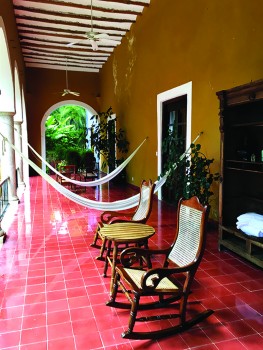When you think of the Yucatan, what comes to mind first? Gorgeous beaches in Cancun and the Riviera Maya? Yes, but that is really just a small part of what you will find in the tropical jungle areas of the Yucatan, a peninsula in the southeastern part of Mexico, snuggled into the Gulf of Mexico. The interior is filled with fascinating and unusual things to see and do. Having just returned from there, I am eager to share some of the highlights of my visit.
Let’s start with Celestun, a biosphere reserve on the western part of the Gulf, a sanctuary to over 200 species of birds and home to one of the largest migratory flamingo populations in the world. That is a sight, floating through dense tunnels of mangrove trees bordering this inlet.
Cenotes, deep fresh clear water holes in caves, are numerous in the Yucatan area. The word “cenote” was created by the Spaniards from a Maya word and was the only way to obtain fresh water in the jungle. Today they are popular sites to swim in, certainly something that everyone might want to do once.
The Yucatan was the major producer of sisal, the strongest fiber in the world, until after WWII when it was replaced by plastic. Sisal haciendas dotted the Yucatan countryside where each hacienda was a self-contained small town with vast acres of agave plants from which sisal was created. Today many of these hacienda estates are still there. Sisal (called green gold) made many landowners rich. The word sisal is a bit of a misnomer as when it was finished and crated to be shipped around the world, it was taken to a port called Sisal with the crates labeled “Sisal” on the outside. People mistakenly thought that was the name of the contents, which in real terms was “henequen.” Visiting a working hacienda is great, but it is even better to stay in one that has been converted into a five-star hotel. These hotels are awesome!
The Maya influence and culture dominates the Yucatan. Some of the most splendid Maya ruins are found here, such as Chichen Itza, considered one of the largest Maya cities ever built and a UNESCO world heritage site. Here you find the massive Kukulkan Pyramid, noted in 2010 as one of the Seven Wonders of the World. Kukulkan means plumed serpent and was an important snake deity to the Maya. But there are many impressive Maya ruins dotting the countryside that are worth visiting, such as Uxmal and Kabah, some of my favorites.
I love Yucatan for all of the unique experiences. Let me know if you would like to join my group trip there. Linda Stack-Chenok, llstack@q.com.

